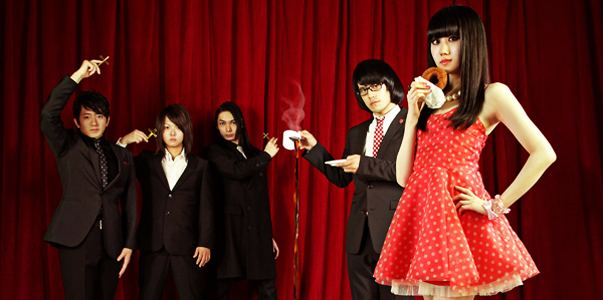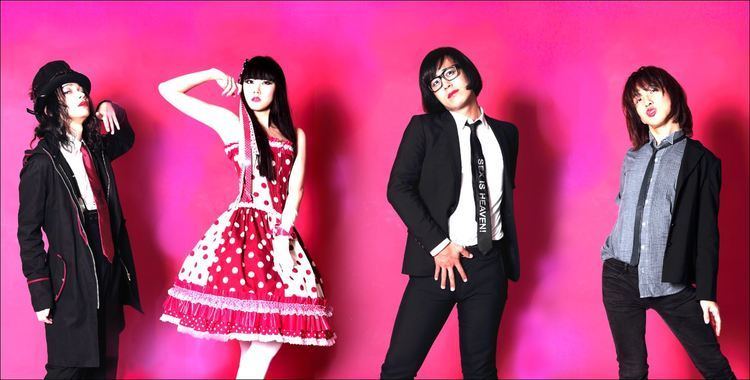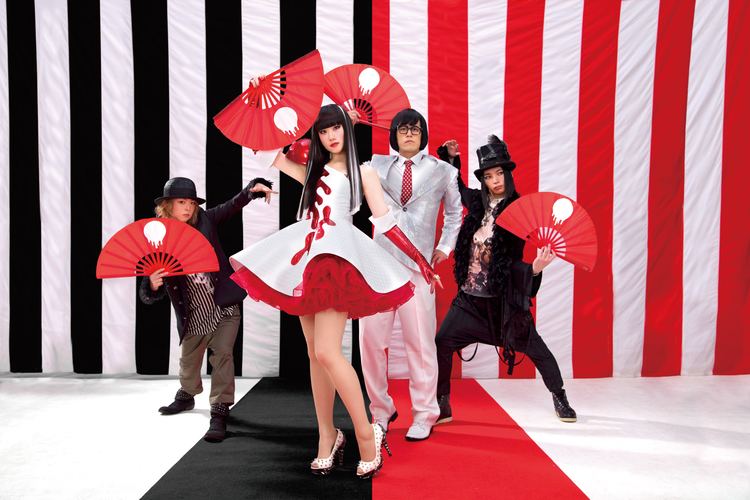Active from 2002 | ||
 | ||
Albums Geiger Counter Culture, Mental Healzu Members Matsunaga Temma, Hamasaki Yoko, Kyōichi Kagiyama, Zeze Shin, Kei Yachimura Similar Kenji Ohtsuki, Passpo, Kinniku Shōjo Tai, Shinsei Kamattechan, Seiko Oomori Profiles | ||
Urbangarde a kon 26 video comment
Urbangarde (アーバンギャルド) is a Japanese band active since 2002. The formation is based in Tokyo and is currently composed of Hamasaki Yoko alias Yokotan (vocals), Matsunaga Temma alias Tenma (vocals), Zeze Shin alias Shinsama (guitar), the drummer Kagiyama Kyoichi alias Kyouchan left the band and they are now looking for a new drummer. Yachimura Kei alias Yashi (keyboard) was also part of the band in its earlier stages.
Contents

Urbangarde's music is characterized by its blend of electronic, pop, rock and various other musical styles. The mix of male and female vocals from Matsunaga Temma and Hamasaki Yoko often speak of social issues in Japan such as the high suicide rate, teen prostitution, teen pregnancy, death and disease. Urbangarde's lyrics and music videos have a reputation of sometimes being shocking and thought-provoking. The name of the band is a mix of the word "urban" and part of the French expression "avant-garde" which means experimental or innovative.

Style and influences

Urbangarde's musical styles varie from bubblegum pop to 80s style synthpop, punk, progressive rock, chiptune, new wave, goth, industrial and heavy metal. The members of the band sometimes define what they do as « Tokyo Virginity Pop » or « Trauma Techno Pop ». The use of visual arts to support their music and ideas is a large part of their act, with performance art, otome (virginal) and Lolita fashion. They have also been known to sometimes read poetry in live shows. Tenma is responsible for the artistic aspects of the band and notably writes the lyrics, takes care of the general design of the band's image, promotional videos and music videos. Their numerous music videos often incorporate disturbing imagery such as blood, weapons, representations of suicide and a giant Kewpie doll that is often present in live performances as well. According to Matsunaga Temma, the doll represents a baby created by modern society. Red and white polka dots and sailor suites are often used as an icon of Urbangarde. In an interview for JRock247 in January 2013, Tenma said ; «There’s a “shoujo (girl)” religion unique to Japan which has the sailor uniform and straight black hair as its icons, and you can’t separate those from sexuality and gender. In Japan’s case, it’s not only the demand from the male side, but also the female side has the desire to be young and to remain as a girl. The Loli-con/Lolita complex is shared by both genders. This is based on the sense of beauty in this country centered around being a girl, and youth isn’t a weakness but sometimes a strength. All of the main characters of the Japanese anime and manga are boys and girls. We took these traditional expressions, and we cannibalized them for our PVs.» It is cited on their official website that the band represents the « minority of underground cultures, virgins and otakus ». For these reasons, their success grew heavily on the internet.

Hamasaki Yoko and Matsunaga Temma said in a PXLBBQ interview in France that Serge Gainsbourg is one of their influences. Technopop from the 80s is also a big inspiration for Matsunaga Temma.
History

Urbangarde was created by lyricist, poet and man of the theatre Matsunaga Temma after meeting Hamasaki Yoko, who then sang old French songs. After seeing one of her performances, Matsunaga Temma recognized her talent and decided to make her the lead singer of the band. They started to significantly rise in popularity in 2007 after having passed the audition for Yahoo! Japan ・WHO’S NEXT and making it in the top 5 in over 3000 bands. After the release of the first three indie albums, their major debut singles "Skirt Kakumei" and "Tokimeki ni Shisu" were released under Universal Music Japan in 2011. The following album "Mental Hells" was their first major label album release. They then started performing for crowds of over 1000 in Tokyo and their 2012 album "Geiger Counter Culture" reached position number 10 on the daily Oricon chart in Japan and made the top 25 on its weekly chart. The album was a reflection on the post-Fukushima era in Japan. In an interview by Daniel Robson from noisy.vice.com, Tenma said ; «[...] after the earthquake there has been a lot to get pissed off about in Japanese politics, and now we feel like we have a message to get across.» Urbangarde also participated in several seasons of the TV program Japan in Motion (NOLIFE TV), which eventually led them to perform live at the Toulouse Game Show in December 2012. Since then, the band has an ever growing fanbase in France. The band also performed at Paris' anime mega-fest Japan Expo in July 2013 and then released their greatest hits compilation "Koi to Kakumei to URBANGARDE" featuring their new opus "Tokai no Alice". Urbangarde's new album "Utsukushii Kuni" came out in June 2014. The title "Utsukushii Kuni" (Beautiful Country) is actually a play on words. Shinzo Abe, the Japanese prime minister, used the phrase as a title of his book and in a political speech during his first term. Urbangarde intentionally used the wrong Chinese character 鬱(utsu=depression) instead of 美しい(utsukushii=beautiful). The album features artwork by Makoto Aida, a contemporary Japanese painter renowned for his provocative works of manga, painting, video, photography and sculpture.
Albums

Singles
Songs
Mahousyoujyo to YobanaideGeiger Counter Culture · 2012
さよならサブカルチャーGeiger Counter Culture · 2012
都会のアリス恋と革命とアーバンギャルド · 2013
